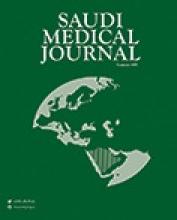Abstract
OBJECTIVE: The objective is to correlate the symptoms of gastroesophageal reflux with the results of esophageal reflux with the results of esophageal pH metry in asthmatic patients.
METHODS: A prospective study was carried out in King Fahd Hospital of the University, Al-Khobar, Kingdom of Saudi Arabia (KSA), during the period January 2000 through to February 2001, whereby 50 patients (34 females and 16 females) with primary diagnosis of bronchial asthma were consecutively enrolled, their mean age + SD was 38.01 + 9.8 years. Twenty-two subjects who were not suffering from asthma or gastroesophageal reflux (GER) (13 females and 9 males) constituted the control group. A questionnaire was administered to all participants and demographic data; asthma and GER symptoms were obtained. Esophageal manometry was performed, whereby the location, length and resting pressure of the lower esophageal sphincter (LES) were determined, pH catheter was inserted nasogastrically, and ambulatory pH data over 24 hours were collected. Pulmonary function tests were also performed.
RESULTS: Twenty-two (44%) patients with asthma had a Demeester score greater than 14.7 and were therefore diagnosed as having pathological GER. Accordingly, the asthma patients were divided into 2 groups, asthma patients with GER (n=22) and those without GER (n=28). Multiple logistic regression analysis revealed that age did not significantly influence occurrence of GER, but it indicated that hoarseness of voice and nocturnal symptoms were significant predictors for the presence of GER in asthmatic patients, hence, the probability of having GER in an asthma patient is nearly 8 times if he/she has nocturnal symptoms and about 7 times if they have hoarseness of voice. However 36.4% of asthmatic patients diagnosed by esophageal ph metry as having GER did not complain of heartburn and hoarseness of voice; such as the reflux was silent.
CONCLUSION: The frequency of GER among 50 patients with asthma reporting to KFHU, Al-Khobar, KSA is 44%. The presence of nocturnal symptoms and hoarseness of voice are significant clinical predictors of GER in asthmatic patients. Patients with difficult to treat asthma should be subjected to esophageal pH metry since a substantial proportion of them may have silent reflux.
- Copyright: © Saudi Medical Journal
This is an open-access article distributed under the terms of the Creative Commons Attribution-Noncommercial-Share Alike 3.0 Unported, which permits unrestricted use, distribution, and reproduction in any medium, provided the original work is properly cited.






